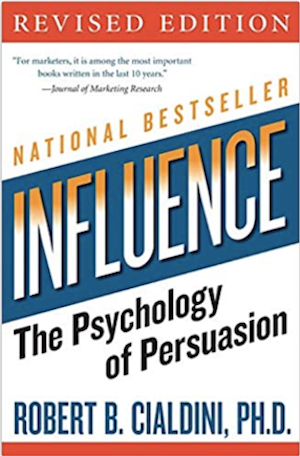Well-known psychologist Robert Cialdini published a book in the 1980s entitled Influence: The Psychology of Persuasion. Although the book is nearly 40 years old at this point, the six principles of persuasion that Cialdini outlined in the book are perhaps even more prominent in the world of retail marketing today. There are many ways retailers trick us into spending more money.
How Online Retailers Trick You Into Spending More
Those six principles include:
- Reciprocity: referring to our innate desire to give back when we receive something
- Scarcity: the perception of limited resources or time
- Authority: how we perceive things as more legitimate when supported by an “expert”
- Consistency: we’re more likely to remain loyal to a person or organization who offers meaningful benefits
- Liking: we’re more likely to be persuaded by those whom we already trust and like, as opposed to an unknown person/business
- Social Proof: we’re more likely to want/buy something that other people have and favorably review
Altogether, the 6 principles of social influence play massive, yet largely unconscious roles in our consumer habits, especially when it comes to online shopping. This is why it’s crucial to be aware of the ways in which retailers use persuasion to encourage us to buy now, spend more, and rack up debt for the sake of “retail therapy.” Here are just six of the many ways in which retailers trick us into spending more money.
Spend X to Get Y
There’s a 99.99% chance you’ve seen many of these types of persuasive appeals while shopping before. They often appear as “Spend $50 to get free shipping” or “Spend $100 to get a $20 gift card” or “Buy 2, get one for 50% off” and the like. This can be problematic for your wallet because you may have only intended to buy one or two small items but the tantalizing offer subliminally encourages you to add a few more things to your cart to be eligible for the reward.
To overcome this temptation, commit yourself to only buying what you need. Granted, this is easier said than done, but keeping in mind your long-term financial goals while navigating the e-commerce sphere can help remind you what’s most important (it’s not the “free” shipping).

“Biggest Sale of the Year!”
It seems like every sale these days is the “biggest” sale of the month/season/year. Retailers use the language of BIG and BLOWOUT to convince us that we must act immediately to access the “best” deals possible, lest we experience the regretful FOMO (fear of missing out) that could arise if we miss this sale.
The same principle applies here: if you don’t need something, then you’re not really “saving money” by splurging on your favorite stores’ extravagant sales. Most places have some kind of sale going on all the time, and even if you miss the “big one,” you can at least feel comforted in knowing you didn’t let impulsive spending take the wheel and obliterate your budget in the process.
Website Timers
Another scarcity-type of tactic retailers use to urge consumers to buy, buy, buy is the use of a visual countdown clock on their website. 24-hour sales are popular among e-commerce websites, even though some of their sales last longer than 24 hours! The trick here is the assumption that you won’t be back on their site once you’ve made your huge purchase, so you wouldn’t even realize the “24 hours only” sale is actually 48-72+ hours.
To circumvent this sneaky, in-your-face tactic, ignore the timer entirely. If you must, put the items in your cart and wait a few hours or days to see how you still feel about those things without the constant threat of time running out driving your purchasing decisions. Once the urgency of the offer is out of the picture, you may feel less compelled to go through checkout and buy more stuff that you don’t really need after all.

“Subscribe to Our Newsletter!”
This technique draws on the principles of reciprocity and consistency. Most retailers have email lists that they use to bribe prospective and former customers alike to come back and buy more things. They’re legally required to request consent from consumers to send you these promotions, so they typically entice people to sign up with the promise of a promo code or free shipping offer accessible only from the email you’ll receive after signing up.
While it’s understandably tempting to get a quick discount and promise to yourself that you’ll unsubscribe after completing your purchase, the fact of the matter is that most people are content with continuously receiving special offers long after that introductory discount. When promotions are constantly showing up in your inbox, it can be enormously difficult to abstain from buying more and more things, so avoid signing up for any retailers’ newsletter at all costs. It’s not worth clogging your inbox and potentially risking your information being sold or shared with third parties.
Like this article? Sign up for Money Q&A’s Email Newsletter, and we’ll send you a regular digest of our newest articles each week as well as exclusive giveaways, deals, and tips just for our email subscribers.
It is full of the answers to your most pressing money, investing, retirement, insurance, and other financial questions. And, it is all free! So, why wait? Click here to sign up now.
Subscribe to get new blog posts in your email!
Sale Price Manipulation
Amazon is often viewed as guilty of price manipulation, which is when they artificially raise and lower prices to distort consumers’ perceptions of what a great “deal” they must be getting. Amazon isn’t alone in this, of course; plenty of retailers love promoting steep discounts for items that were already overpriced to begin with because this makes it seem as though you’re paying a fantastic price compared to its retail value.
For example, if you see something normally priced at $30 but the sale price (usually in red and/or bold text to capture your attention) is only $19.99, then it may look like you’re saving a whopping 30% on that item. In reality, you’re just buying something because it looks like a great bargain, not because it actually is.
To conquer price manipulation tactics used by retailers, the Honey browser extension is a useful tool for evaluating the price history of an item on several major websites.
“Before You Go…”
Another FOMO-inspired tactic that retailers love is an automatic pop-up message that appears when your cursor appears to be headed for the exit button on the webpage. It’s called an exit intent message, which is designed to dissuade you from leaving by enticing you with an offer you didn’t previously see while browsing their site.
To avoid this, enabling pop-up blockers can be effective for preventing some of these exit messages, but some retailers have figured out ways around these, too. Remember, if you were already planning on leaving the site, then follow through. Awareness of exit-intent messages and their sneaky persuasive capabilities is the first step to recognizing that you’re being baited to come back and spend money, so run for the hills the moment you see one.
These are just some of the many different ways in which online retailers use the principles of persuasion to convince you to spend more money on their products and services. It’s not enough to say you won’t fall prey to these tactics because many of them operate in subtle, nearly-unconscious ways backed by the best consumer psychology research out there.
However, knowing what to look out for and staying firm about your intended purchasing decisions can be a powerful counter-force to these urgent, “buy now!” messages.

